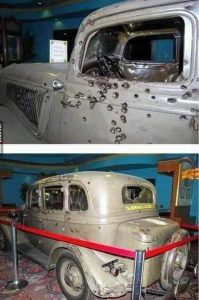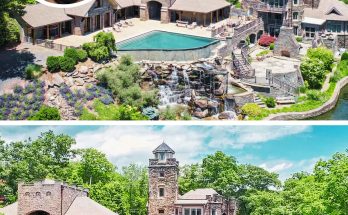The car where Bonnie and Clyde’s last ride took place is one of the most iconic vehicles in American history. On May 23, 1934, the infamous outlaws Bonnie Parker and Clyde Barrow were ambushed and killed in Bienville Parish, Louisiana, by law enforcement officers in a brutal confrontation.
Here’s a breakdown of the car’s history and the events leading up to Bonnie and Clyde’s dramatic end:
The Car: A 1934 Ford V8
Make and Model: The car was a 1934 Ford V8, which was famously known for its power and speed during the era. It was one of the fastest cars available at the time, making it the perfect getaway vehicle for a notorious pair of criminals who relied on speed to evade the police.
Color: The car was black, a common color for cars in the 1930s.
Features: The Ford V8 was well-known for its powerful engine, which allowed Bonnie and Clyde to outrun law enforcement on many occasions. This was particularly important for the duo, who spent the latter years of their criminal careers on the run, robbing banks, and frequently engaging in shootouts with police.
The Ambush in Bienville Parish, Louisiana
Setting: On May 23, 1934, Bonnie and Clyde were ambushed on a rural road in Bienville Parish, near Sailes, Louisiana. The couple had been on the run for more than two years, leaving behind a trail of violent robberies and murders. The law enforcement officers, led by Frank Hamer, a former Texas Ranger, had been tracking them for months. They received information about the couple’s whereabouts and set up a deadly ambush.

The Trap: Officers had positioned themselves in the ditch along Highway 154, where the ambush took place. They had tipped off a local mechanic, Ted Hinton, who was familiar with the couple and gave the lawmen an idea of the vehicle they were driving. As the Ford V8 approached the ambush point, the officers opened fire with automatic rifles.
The Death of Bonnie and Clyde
Gunfire: As the Ford V8 rolled towards the officers, they unleashed a barrage of gunfire, emptying 130 rounds into the car. Both Bonnie and Clyde were killed instantly in the car, riddled with bullets. Bonnie was seated in the passenger side, and Clyde was driving.
Bullet Damage: The car was absolutely riddled with bullets. Multiple bullet holes could be seen in the windshield, doors, and even the tires. The vehicle became a testament to the firepower and precision used in the ambush, with shots hitting the couple from all angles. It was a dramatic end to the crime spree that had terrorized the Midwest and South.
Aftermath: The Car as a Crime Scene
Post-ambush: After the ambush, the car and the bodies were left at the scene for several hours. It was a spectacle for law enforcement and locals alike, who swarmed the area. At the time, the news of their deaths sent shockwaves through the country, as the couple had become infamous symbols of the Great Depression era.
The Car’s Fate: After the ambush, the car was towed to Arcadia, Louisiana, where it was displayed for the public to see. People were fascinated by the vehicle’s bullet-riddled appearance, and it became an instant tourist attraction. Souvenirs from the car were taken by onlookers—everything from bullet casings to pieces of the car’s shattered glass.
Legacy of the Car
Display and Museum: The 1934 Ford V8 that Bonnie and Clyde were in was eventually put on display at a local police station in Arcadia, Louisiana. Over the years, it made its way to various exhibitions, and parts of the car were displayed in museums across the country.
The Car Today: In more recent years, parts of the car were exhibited at the Whitney Plantation Museum in Louisiana, while other pieces were sold or put into private collections. However, the fully intact car was later sold to a private collector and is now part of the Texas Ranger Hall of Fame and Museum in Waco, Texas.
Cultural Impact
Bonnie and Clyde became legends of American criminal history. The car where they met their end symbolizes the tragic and violent nature of their lives, and it has become a symbol of the Depression-era outlaws who were both feared and romanticized.
In the years following their deaths, their story has been immortalized in films, books, and songs, with many depicting them as Robin Hood-like figures, even though their criminal activities involved murder, bank robberies, and other violent crimes.
Films: The 1967 film “Bonnie and Clyde” (starring Warren Beatty and Faye Dunaway) is one of the most famous portrayals of the couple’s story, and the iconic image of their car in the final shootout is often used in popular culture to represent the end of their reign of terror.
Conclusion
The 1934 Ford V8 that carried Bonnie and Clyde during their final ride is more than just a car—it has become an iconic relic of American history, symbolizing the end of one of the most famous criminal partnerships of the 20th century. The bullet-riddled car still stands as a haunting reminder of their tragic end and the relentless lawmen who brought their reign of terror to a close in the backroads of Louisiana.



